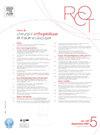患者对创伤学患者报告结果措施(PROMs)数字汇编的依从性:现实还是幻觉?
Q4 Medicine
Revue de Chirurgie Orthopedique et Traumatologique
Pub Date : 2025-01-17
DOI:10.1016/j.rcot.2024.12.013
引用次数: 0
摘要
患者报告结果措施(PROM)的数字化收集可能有助于减少创伤科患者随访中的数据丢失。假设我们的假设是,在创伤人群中,非物质化PROM集合的随访依从率与文献中发现的低于25%的依从率相似。这是一项前瞻性的单中心队列研究,在2022年12月至2023年2月的3个月时间内进行,对应于冬季创伤学(冬季运动)的高活动时期。在Orthense.com®数字平台(Digikare Inc.)上,所有接受单次骨折治疗的患者都接受了PROM收集随访协议。法国布拉尼亚克)被邀请积极参与非物质化的后续工作和PROM的收集。在创伤后3个月的电话提醒中,患者被问及数字随访的有用性、随访方案提供的建议的质量和有用性,以及1年随访的依从性。结果在64名患者中,25名患者(39%)参与了数字随访和PROM收集,但只有13名患者(20%)表示愿意在创伤后1年继续进行非物质化PROM收集。所有应答患者均为手术患者(p = 0.02)。没有其他标准在统计上与依从率有关。在25名激活和使用账户的患者中,14人(56%)认为远程数字随访对他们的护理有帮助。根据协议提供的建议,8名患者(32%)避免了与主治医生或外科医生的紧急咨询。结论如果3个月时对创伤学非物质化PROM收集的有效回复率高于我们最初的假设,那么1年报告的回复率与文献中报告的随访率一致。效用(指用户所提供的咨询,但最成功避免了议定书具有8例患者(32%)的紧急商量他们的主治医师或外科医生必须使用这些工具,鼓励医生意识到他们未来不会产生革命性的跟踪病人的创伤。证据水平II;非受控前瞻性队列研究。收集数字化患者报告结果测量(PROM)可以帮助减少创伤患者监测中的数据丢失。我们的假设是,在创伤人群中监测患者的背景下,对PROM电子收集的反应率与文献中发现的合规性率相似,即小于25%。这项前瞻性的单中心队列研究在2022年12月至2023年2月期间进行,为期3个月,对应于一段高冬季创伤活动(冬季运动)时期。所有接受单骨折治疗的患者都要接受Orthense.com®(Digikare Inc.)上收集PROM的后续协议。来自法国布拉尼亚克)被邀请积极参与PROM的非物质化后续行动和收集。在创伤后3个月的电话提醒中,患者被问及数字监测的可用性、监测方案提供的建议的质量和可用性以及1岁时数字监测的合规性。在64名患者中,25名患者积极参与数字监测和PROM收集(39%),但只有13名患者(20%)表示自己在创伤后1年准备继续收集电子PROM。所有有反应的患者均为手术患者(P = 0.02)。没有其他标准在统计上与回复率有关。在25名激活和使用账户的患者中,14人(56%)发现远程数字监控对他们的护理有用。该方案提供的建议使8名患者(32%)能够避免紧急咨询全科医生或外科医生。结论:虽然创伤患者在3个月时对收集电子PROM的反应率高于我们最初的假设,但它与创伤后1年文献中报告的随访率一致。数字平台Orthense.com®(Digikare Inc.)的监控协议用户报告的使用情况。Blagnac),法国为了研究目的),“长老议定书which it made the advice所代理之间尽可能8例患者(32%)from in their紧急,consulting (surgeon general inshpo黄金应该鼓励traumatologists to use these in mind that they will not future-oriented tools,一只revolutionize外伤病人的监测》。证据水平II,无对照组前瞻性研究。本文章由计算机程序翻译,如有差异,请以英文原文为准。
Adhésion des patients au recueil numérique des Patient-Reported Outcome Measures (PROMs) en traumatologie : réalité ou illusion ?
Introduction
Le recueil de Patient-Reported Outcome Measures (PROMs) digitalisé pourrait permettre de réduire les pertes de données dans le suivi des patients en traumatologie.
Hypothèses
Notre hypothèse était que l’adhésion au recueil dématérialisé de PROMs dans le cadre du suivi des patients issus d’une population de traumatologie serait similaire au taux d’observance inférieur à 25 % retrouvé dans la littérature.
Matériels et méthodes
Il s’agit d’une étude prospective de cohorte monocentrique conduite sur une période d’inclusion de 3 mois entre décembre 2022 et février 2023 correspondant à une période à haute activité de traumatologie hivernale (sports d’hiver). Tous les patients pris en charge pour une fracture unique faisant l’objet d’un protocole de suivi avec recueil de PROMs sur la plateforme numérique Orthense.com® (Digikare Inc. Blagnac, France) étaient invités à participer activement au suivi dématérialisé et au recueil de PROMs. Au rappel téléphonique à 3 mois du traumatisme, les patients étaient questionnés sur l’utilité du suivi numérique, la qualité et l’utilité des conseils fournis par les protocoles de suivi et l’observance du suivi numérique à 1 an.
Résultats
Parmi les 64 patients inclus, 25 patients ont participé au suivi numérique et au recueil de PROMs (39 %) mais seulement 13 patients (20 %) se déclaraient prêt à poursuivre le recueil de PROMs dématérialisé à 1 an du traumatisme. Tous les patients répondeurs étaient des patients opérés (p = 0,02). Aucun autre critère n’était associé statistiquement au taux d’observance. Parmi les 25 patients ayant activé et utilisé leur compte, 14 (56 %) ont jugé le suivi numérique à distance utile dans leur prise en charge. Les conseils fournis par les protocoles ont permis d’éviter à 8 patients (32 %) de consulter en urgence leur médecin traitant ou leur chirurgien.
Conclusion
Si le taux de réponse effectif au recueil de PROMs dématérialisé en traumatologie à 3 mois est supérieur à celui de notre hypothèse de départ, le taux de réponse déclaré à 1 an rejoint le taux de suivi rapporté dans la littérature. L’utilité rapportée par les utilisateurs mais surtout les conseils fournis par les protocoles ayant permis d’éviter à 8 patients (32 %) de consulter en urgence leur médecin traitant ou leur chirurgien doivent inciter les traumatologues à utiliser ces outils d’avenir en étant conscient qu’ils ne révolutionneront pas le suivi des patients en traumatologie.
Niveau de preuve
II ; étude de cohorte prospective non contrôlée.
Introduction
The collection of digitalized Patient-Reported Outcome Measures (PROMs) could help reduce data loss in the monitoring of trauma patients.
Hypothesis
Our hypothesis was that response rate to the electronic collection of PROMs in the context of monitoring patients from a trauma population would be similar to the compliance rate found in the literature, i.e. less than 25%.
Methods
This is a prospective single-center cohort study conducted over a 3-month inclusion period between December 2022 and February 2023 corresponding to a period of high winter trauma activity (winter sports). All patients treated for a single fracture subject to a follow-up protocol with collection of PROMs on the digital platform Orthense.com® (Digikare Inc. Blagnac, France) were invited to actively participate in the dematerialized follow-up and collection of PROMs. At the telephone reminder 3 months after the trauma, patients were questioned about the usefulness of digital monitoring, the quality and usefulness of the advice provided by the monitoring protocols and compliance with digital monitoring at 1 year.
Results
Among the 64 patients included, 25 patients actively participated in digital monitoring and the collection of PROMs (39%) but only 13 patients (20%) declared themselves ready to continue the collection of electronic PROMs 1 year after the trauma. All responding patients were operated patients (P = 0.02). No other criterion was statistically associated with the response rate. Among the 25 patients who activated and used their account, 14 (56%) found remote digital monitoring useful in their care. The advice provided by the protocols enabled 8 patients (32%) to avoid having to urgently consult their general practitioner or surgeon.
Conclusion
Although the response rate to the collection of electronic PROMs in trauma at 3 months is higher than that of our initial hypothesis, it matches the follow-up rate reported in the literature at 1 year after the trauma. The usefulness reported by users of the monitoring protocols of the digital platform Orthense.com® (Digikare Inc. Blagnac, France) but especially the advice provided by the protocols which made it possible to avoid 8 patients (32%) from consulting in emergency, their general practitioner or surgeon must encourage traumatologists to use these future-oriented tools, keeping in mind that they will not revolutionize the monitoring of trauma patients.
Level of evidence
II, prospective study without control group.
求助全文
通过发布文献求助,成功后即可免费获取论文全文。
去求助
来源期刊

Revue de Chirurgie Orthopedique et Traumatologique
Medicine-Surgery
CiteScore
0.10
自引率
0.00%
发文量
301
期刊介绍:
A 118 ans, la Revue de Chirurgie orthopédique franchit, en 2009, une étape décisive dans son développement afin de renforcer la diffusion et la notoriété des publications francophones auprès des praticiens et chercheurs non-francophones. Les auteurs ayant leurs racines dans la francophonie trouveront ainsi une chance supplémentaire de voir reconnus les qualités et le intérêt de leurs recherches par le plus grand nombre.
 求助内容:
求助内容: 应助结果提醒方式:
应助结果提醒方式:


